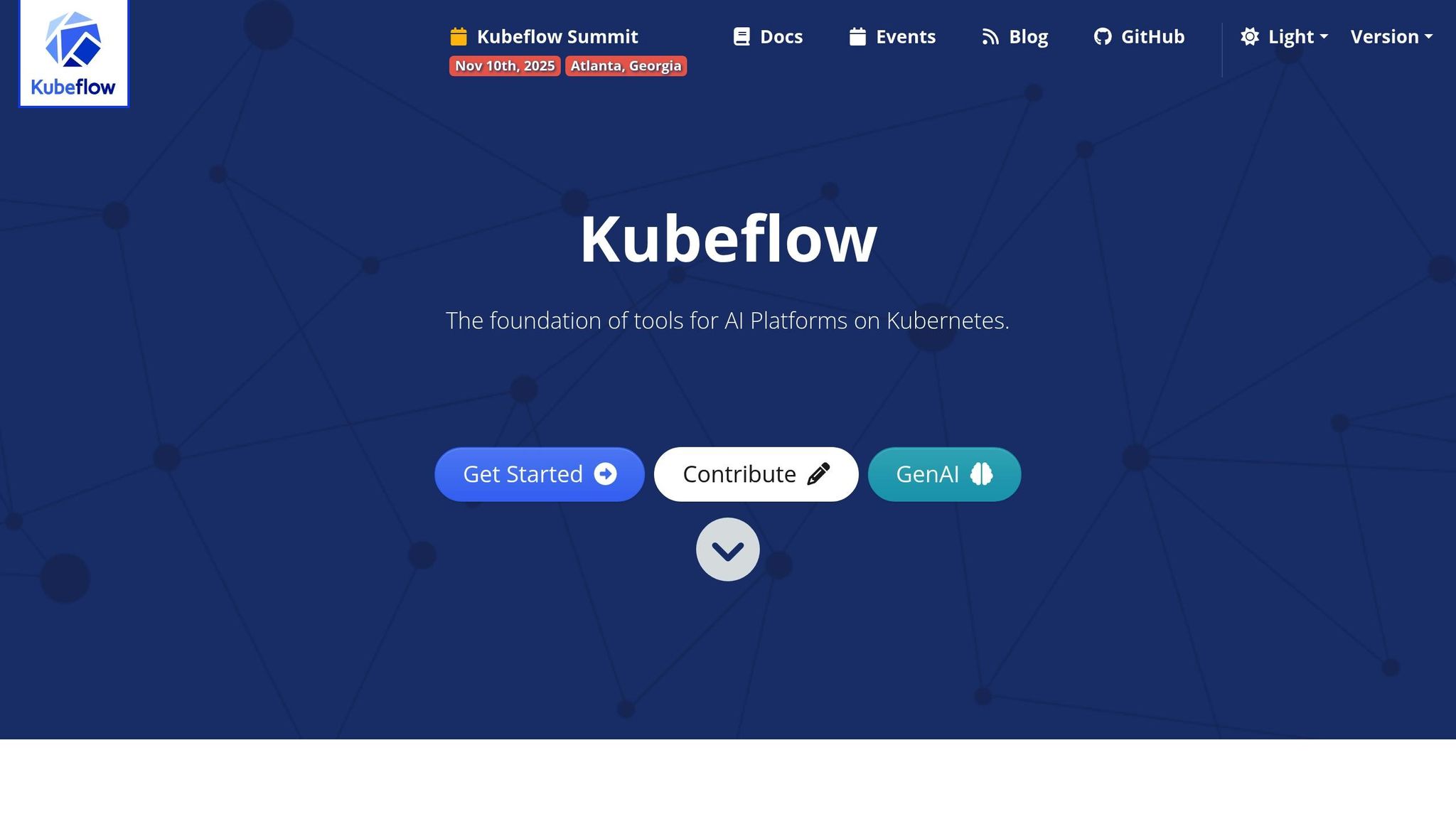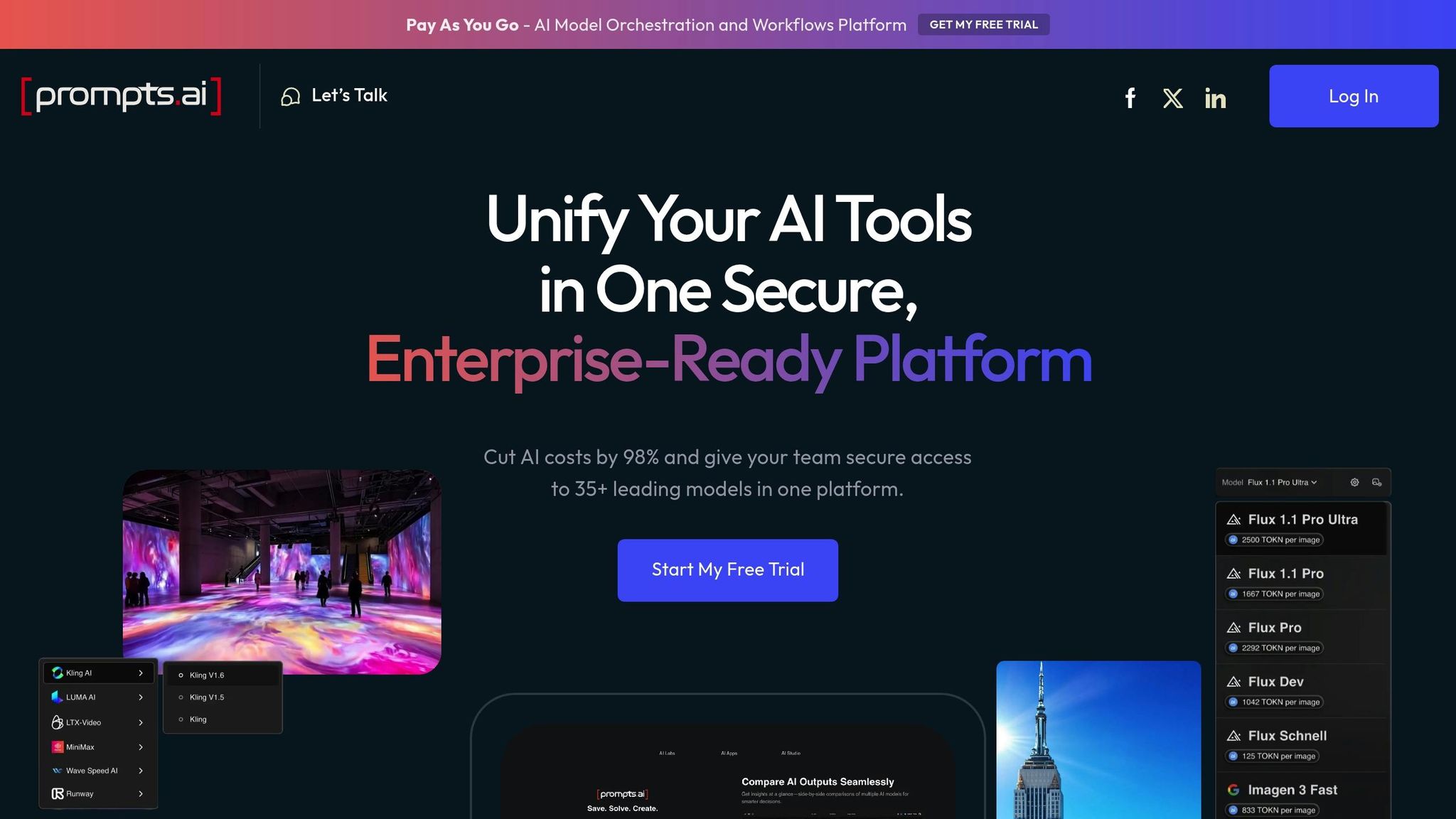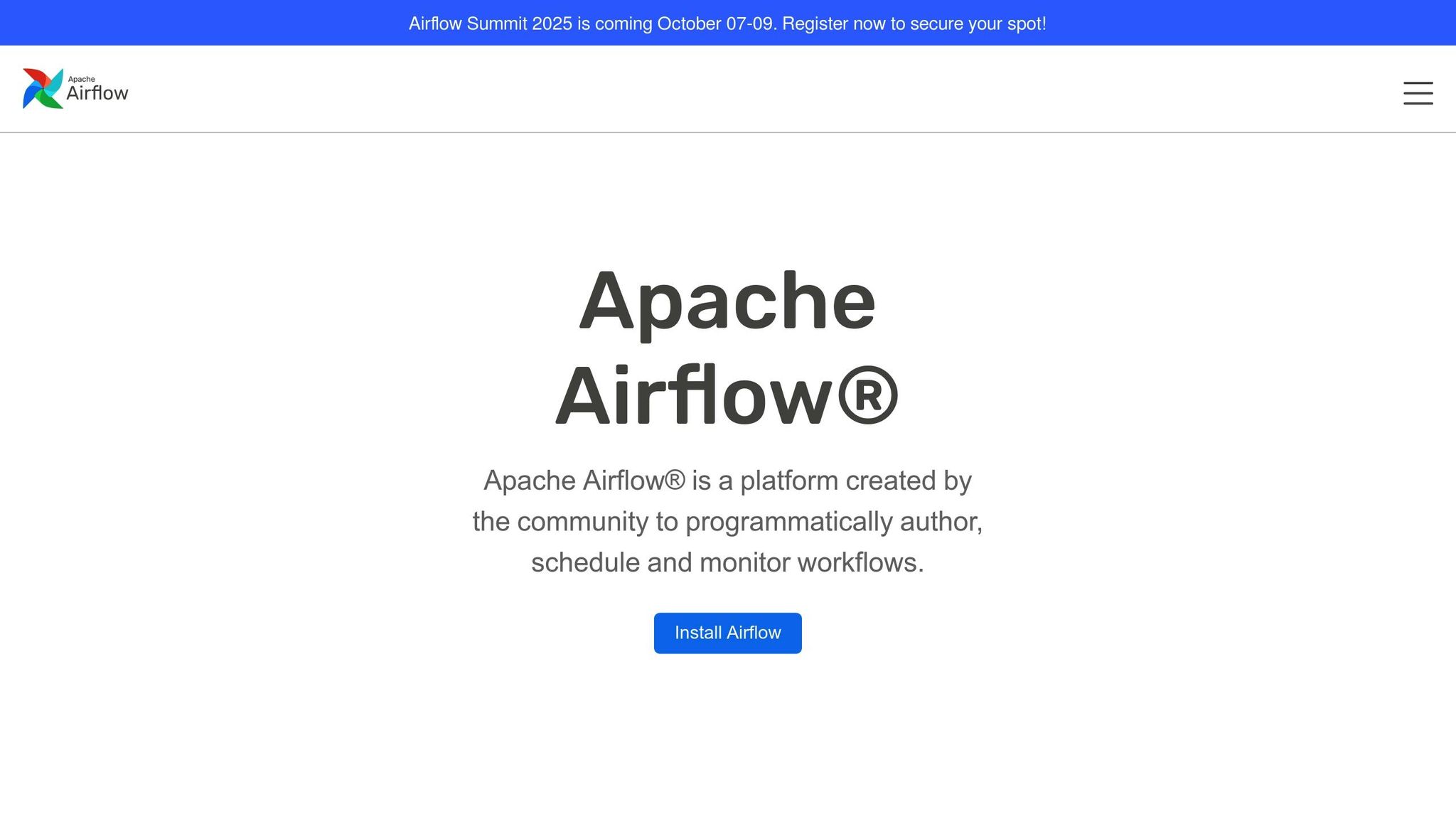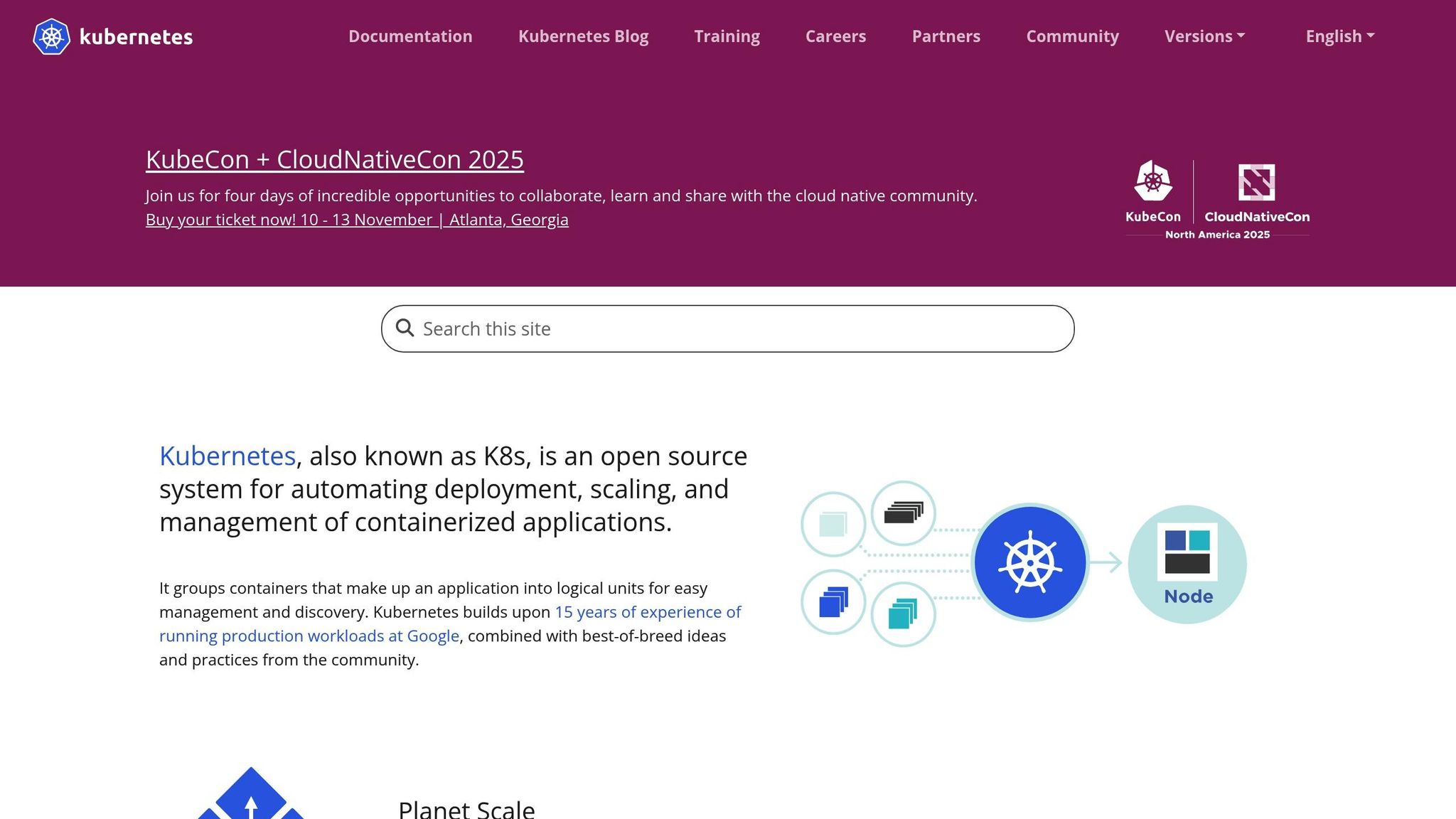
Las plataformas de aprendizaje automático están transformando el desarrollo de la IA, simplificando procesos complejos como la preparación de datos, el entrenamiento de modelos y la implementación. Con el 92% de los ejecutivos pronosticando Flujos de trabajo impulsados por IA para 2025, elegir la plataforma adecuada es fundamental para escalar las operaciones y reducir los costos.
He aquí un resumen rápido de las cuatro plataformas principales:
Cada plataforma tiene puntos fuertes y limitaciones, desde la gobernanza hasta la escalabilidad. Usa la comparación que aparece a continuación para identificar la mejor opción para tu equipo.
Explore estas plataformas en función de sus necesidades, ya sea para simplificar los flujos de trabajo, reducir los costos o escalar las operaciones de IA.


Prompts.ai es una sólida plataforma de orquestación de IA diseñada para uso empresarial, que reúne más de 35 modelos lingüísticos de gran tamaño, incluidos GPT-5, Claude, Llama, y Géminis, en un centro centralizado. Al consolidar estas herramientas, elimina el desafío común de administrar los recursos de IA dispersos en múltiples plataformas.
La plataforma brilla al integrar estos diversos modelos en un espacio de trabajo único y seguro. Los equipos pueden comparar fácilmente los modelos uno al lado del otro, lo que garantiza flujos de trabajo consistentes y una toma de decisiones simplificada.
Prompts.ai también destaca por su capacidades de automatización, con flujos de trabajo prediseñados conocidos como «Time Savers». Estos flujos de trabajo simplifican las tareas empresariales rutinarias e incluyen controles FinOps para el seguimiento de los costos basado en fichas. En lugar de crear procesos desde cero, las organizaciones pueden personalizar estos flujos de trabajo para satisfacer sus necesidades específicas, ahorrando tiempo y esfuerzo.
Escalabilidad es otro punto fuerte clave. La plataforma permite a las organizaciones expandirse instantáneamente añadiendo modelos, usuarios o equipos, mediante un sistema de crédito TOKN de pago por uso. Este modelo de precios flexible es ideal para las empresas con demandas de IA fluctuantes o para aquellas que aún están diseñando sus estrategias de IA a largo plazo. Además de esta escalabilidad, Prompts.ai garantiza el cumplimiento de rigurosos estándares de gobierno.
Cuando se trata de gobierno y cumplimiento, la plataforma ofrece registros de auditoría integrados, seguimiento del uso en tiempo real y controles de datos avanzados. Estas funciones protegen la información confidencial y garantizan que las organizaciones cumplan con los estrictos requisitos de seguridad y cumplimiento, con la ventaja adicional de mantener los datos críticos almacenados en las instalaciones.
Prompts.ai se distingue por combinar el acceso a modelos, la rentabilidad y la gobernanza en una plataforma cohesiva. Este enfoque integrado es particularmente atractivo para las organizaciones que buscan pasar de la experimentación con inteligencia artificial a soluciones a gran escala listas para la producción, sin la molestia de tener que hacer malabares con varios proveedores o enfrentarse a configuraciones técnicas complejas.

TFX está diseñado para transformar los modelos de investigación en sistemas de producción escalables, lo que lo convierte en una solución de referencia para el aprendizaje automático de nivel empresarial. Gestiona todo el ciclo de vida del aprendizaje automático con canalizaciones automatizadas y controles de gobierno sólidos, a la vez que se integra a la perfección con el ecosistema de TensorFlow.
Una de las características más destacadas de TFX es su capacidad para trabajar sin esfuerzo en varios entornos informáticos. Se conecta de forma nativa con herramientas de TensorFlow como Validación de datos de TensorFlow (TFDV), TensorFlow Transform (TFT) y TensorFlow Model Analysis (TFMA). Además, es compatible con los principales motores de orquestación, como Apache Airflow, Apache Beamy Kubeflow Pipelines, lo que brinda a los equipos la flexibilidad de elegir sus herramientas de flujo de trabajo preferidas.
Lo que realmente diferencia a TFX es su enfoque modular y automatizado para administrar canales de aprendizaje automático. Cada etapa de la tubería es manejada por componentes especializados. Por ejemplo, Ejemplo: Gen gestiona la ingesta y la división de datos, Gen de Estadísticas produce estadísticas descriptivas para identificar anomalías, y el Transformar El componente garantiza que el preprocesamiento sea uniforme tanto durante el entrenamiento como durante el servicio, evitando el problema común de un sesgo entre el entrenamiento y el servicio.
La escalabilidad es otro punto fuerte de TFX. Por ejemplo, Vodafone adoptó Validación de datos de TensorFlow en marzo de 2023 para fortalecer sus procesos de gobernanza global. Del mismo modo, Spotify implementó TFX en octubre de 2023 para impulsar la formación continua y ofrecer recomendaciones a gran escala y en tiempo real.
TFX también se destaca en la automatización de la gobernanza. Valida los esquemas, detecta la desviación de datos y evalúa los modelos antes de la implementación. Herramientas como Validador de infrarrojos pruebe modelos en entornos de espacio aislado, mientras Metadatos ML (MLMD) rastrea el linaje de datos en backends como SQLite, MySQL y PostgreSQL.
La satisfacción de los usuarios refleja la eficacia de TFX, con una puntuación compuesta de 8,3/10 y una tasa de renovación del 100%. Un usuario destacó su impacto:
«La suite integral de TFX agiliza la implementación de modelos de aprendizaje automático a escala, lo que garantiza la eficiencia y la confiabilidad».
La implementación es más fácil con TFX Modelo guardado formato, que admite TensorFlow Serving, TensorFlow Lite y TensorFlow JS. También se integra con los servicios de Google Cloud, como Vertex AI Pipelines y Cloud Dataflow sin dejar de ser portátil en configuraciones locales y multinube.
Para las organizaciones que ya han invertido en TensorFlow, TFX ofrece una transición perfecta de la experimentación a la implementación de producción a gran escala. Se centra en automatización, gobierno y escalabilidad lo convierte en una opción poderosa para las empresas que necesitan soluciones de aprendizaje automático confiables y de alto rendimiento.

Apache Airflow se ha convertido en la piedra angular para organizar los flujos de trabajo en las operaciones modernas de aprendizaje automático. A diferencia de las plataformas diseñadas para tareas específicas, Airflow destaca como un orquestador versátil, capaz de gestionar flujos de trabajo complejos en una variedad de herramientas y sistemas. Esta flexibilidad lo convierte en un activo para las organizaciones que trabajan con diversos tipos de tecnología.
Lo que diferencia a Airflow en los flujos de trabajo de aprendizaje automático es su diseño centrado en Python. Con la API de TaskFlow, los desarrolladores pueden usar decoradores para convertir los scripts de Python en tareas de Airflow, lo que simplifica el paso de la experimentación a la producción.
El marco modular de Airflow, basado en colas de mensajes y grupos configurables, está diseñado para gestionar la asignación de recursos y la distribución de tareas de manera eficiente. Esta capacidad es fundamental para los proyectos de aprendizaje automático, que suelen implicar dependencias complejas y necesidades de hardware diversas. Por ejemplo, un proyecto puede requerir un preprocesamiento de datos con un uso intensivo de la CPU, seguido de un entrenamiento de modelos con uso intensivo de la GPU. La función de computación conectable de Airflow garantiza que cada tarea se ejecute en la infraestructura óptima. Su flexibilidad se extiende a una integración perfecta con una amplia gama de herramientas.
El ecosistema de integración de la plataforma es otro punto destacado, ya que permite a los equipos organizar los flujos de trabajo en herramientas populares como MLFlow, AWS SageMaker, Ladrillos de datos, y Robot de datos. En noviembre de 2023, TheFork Engineering demostró las capacidades de Airflow al organizar las canalizaciones de inferencia de Kedro en AWS Batch, integrando datos esenciales y herramientas de calidad.
Para las operaciones a escala empresarial, Airflow ofrece estrategias de ejecución sólidas. El CeleryExecutor usa colas de mensajes como Redis o Rabbit MQ para distribuir las tareas entre varios nodos de trabajo, mientras que KubernetesExecutor activa módulos de Kubernetes dedicados para cada tarea, lo que garantiza el aislamiento y la asignación dinámica de recursos [36,37]. La implementación de Airflow de Shopify ejemplifica su escalabilidad, ya que gestiona más de 10 000 DAG, más de 400 tareas simultáneas y más de 150 000 ejecuciones diarias.
Las capacidades de programación basadas en datos de Airflow abordan los desafíos clave en los flujos de trabajo de aprendizaje automático. La introducción de los conjuntos de datos Airflow permite la activación automática de los DAG de entrenamiento de modelos cuando se actualizan los conjuntos de datos. Además, su función de mapeo dinámico de tareas admite procesos paralelos, como el ajuste de hiperparámetros, sin necesidad de un número predefinido de experimentos.
La plataforma está diseñada teniendo en cuenta la confiabilidad operativa:
«Airflow es el corazón de la pila moderna de MLOps, ya que organiza todo el ciclo de vida del aprendizaje automático».
- Flujo de aire Apache
Para satisfacer las demandas empresariales, Airflow se integra con OpenLineage y proporciona un seguimiento completo del linaje de datos, esencial para la reproducibilidad de los modelos y el cumplimiento de normativas como el RGPD. También incluye funciones como las alertas de nivel de producción, el registro detallado y los reintentos automáticos para mitigar problemas como las interrupciones del servicio o los límites de velocidad.
La adaptabilidad de Airflow es aún más evidente en su proveedor dedicado a DataRobot. Esta integración ofrece operadores listos para usar para tareas como la creación de proyectos, la capacitación y el despliegue de modelos y la puntuación de predicciones. Los sensores supervisan la finalización de las tareas, lo que permite organizar sin problemas los procesos de aprendizaje automático mediante los DAG de Airflow.
Los flujos de trabajo condicionales son otra característica poderosa que permite que las tareas se bifurquen en función de los resultados. Por ejemplo, los equipos pueden implementar un modelo solo si cumple con los parámetros de rendimiento. Las tareas de configuración y desmontaje garantizan entornos reproducibles al automatizar el aprovisionamiento y la limpieza de los recursos.
Con más de 12 000 organizaciones que utilizan Airflow y aproximadamente el 30% de sus usuarios lo aplican a los flujos de trabajo de aprendizaje automático, la plataforma ha demostrado su preparación para los desafíos empresariales [31,40]. Su capacidad para organizar tanto las canalizaciones de datos tradicionales como los flujos de trabajo emergentes de los LLMOP la posiciona como un actor clave en el cambiante panorama del aprendizaje automático [25,28].
Basado en herramientas como Prompts.ai, TFX y Apache Airflow, Kubeflow ofrece un enfoque centrado en Kubernetes para administrar las operaciones de aprendizaje automático (ML). Diseñado específicamente para los flujos de trabajo de aprendizaje automático en contenedores, se integra perfectamente con Kubernetes, lo que lo convierte en la opción ideal para las organizaciones que ya utilizan la infraestructura en contenedores.
«Kubeflow es la base de las herramientas para las plataformas de IA en Kubernetes». — Kubeflow.org
Kubeflow simplifica las complejidades de la organización de contenedores, lo que permite a los científicos de datos concentrarse en el desarrollo. Distribuye las cargas de trabajo de formación entre clústeres e implementa modelos como servicios escalables. Por ejemplo, los Jupyter Notebooks funcionan dentro de Kubernetes Pods, lo que proporciona espacios de trabajo confiables y escalables.
En el corazón de Kubeflow se encuentra Kubeflow Pipelines (KFP), un motor de orquestación que estructura los flujos de trabajo como gráficos acíclicos dirigidos (DAG). Cada paso se ejecuta en su propio contenedor, lo que garantiza la portabilidad y la escalabilidad en todos los entornos. Con una interfaz fácil de usar y un SDK de Python, los equipos pueden crear canalizaciones personalizadas que se adapten a sus necesidades. Este marco permite una implementación perfecta en configuraciones híbridas, locales y en la nube.
La flexibilidad de implementación de Kubeflow satisface una amplia gama de necesidades de infraestructura. Es compatible con configuraciones locales, servicios de Kubernetes en la nube pública (como AWS EKS, Azure AKS y Google GKE) y configuraciones híbridas.
Para los usuarios de Google Cloud, Kubeflow ofrece dos modos de implementación: independiente y completo. Estas opciones incluyen terminales públicos configurados automáticamente y la autenticación mediante proxy con reconocimiento de identidad de Cloud. Los equipos pueden realizar la implementación directamente en Google Kubernetes Engine para obtener un control granular u optar por Vertex AI Pipelines como una alternativa totalmente gestionada.
Las implementaciones locales son especialmente valiosas para las organizaciones que priorizan la privacidad de los datos o prefieren los clústeres privados. Kubeflow se integra con soluciones de almacenamiento empresarial como NFS, Ceph y Portworx, lo que permite compartir volúmenes con funciones de ReadWriteMany para compartir datos y modelos sin problemas. Los ejemplos del mundo real destacan la adaptabilidad de Kubeflow a diversas configuraciones.
«La portabilidad de Kubernetes permite que Kubeflow funcione sin esfuerzo en varios entornos (locales, en la nube o en configuraciones híbridas), lo que garantiza una experiencia de implementación uniforme y permite a los equipos acelerar las cargas de trabajo de IA en Kubernetes con un enfoque de creación única e implementación en cualquier lugar». — Portworx

Kubeflow aprovecha al máximo la automatización y la escalabilidad de Kubernetes para agilizar los flujos de trabajo de aprendizaje automático. Ajusta dinámicamente las cargas de trabajo en función de la demanda, lo que garantiza un manejo eficiente de las tareas de procesamiento a gran escala. Operadores específicos de Framework, como tfJob para TensorFlow y PyTorchJob para PyTorch simplifican la administración de la infraestructura, mientras que herramientas como Katib y KServe mejoran las capacidades automatizadas de aprendizaje automático y servicio de modelos.
Las canalizaciones de Kubeflow admiten lógica avanzada, como bucles paralelos, recursión, almacenamiento en caché y esperas asincrónicas, lo que facilita la gestión de ciclos complejos de desarrollo de IA. Los activadores basados en eventos también se pueden configurar para volver a entrenar los modelos automáticamente cuando los conjuntos de datos se actualizan o el rendimiento disminuye. Esta automatización complementa la versatilidad de integración de Kubeflow.
Kubeflow aborda los desafíos de la colaboración empresarial a través de funciones como el soporte multiusuario y las herramientas de gobierno. Al usar los espacios de nombres de Kubernetes y el control de acceso basado en roles (RBAC), crea entornos seguros y aislados para diferentes equipos. El registro de modelos funciona como un centro centralizado para administrar modelos, versiones y metadatos, lo que fomenta una mejor colaboración.
«Kubeflow puede adaptarse a las necesidades de varios equipos en un solo proyecto y les permite trabajar desde cualquier infraestructura». — Red Hat
La gestión de metadatos garantiza un seguimiento coherente de los experimentos, lo que favorece la reproducibilidad y la gobernanza. El panel central de Kubeflow ofrece una interfaz unificada para gestionar los flujos de trabajo, supervisar los recursos y realizar un seguimiento de los experimentos.
Las soluciones empresariales como dKube mejoran aún más las capacidades de Kubeflow al integrarse con herramientas como Active Directory, LDAP, control de versiones basado en Git y diversas opciones de almacenamiento, incluidos AWS S3, Azure Blob y sistemas locales.
«Kubeflow optimiza los flujos de trabajo de aprendizaje automático de extremo a extremo al facilitar las comunicaciones entre los científicos de datos, los desarrolladores y los ingenieros de aprendizaje automático, lo que facilita el proceso contenerizado para el aprendizaje automático». — GeeksForGeeks
Para las organizaciones que conocen bien Kubernetes y necesitan una organización avanzada de canalizaciones de aprendizaje automático, Kubeflow ofrece una solución integral. Sin embargo, es posible que los equipos que recién comienzan a usar Kubernetes consideren que las plataformas gestionadas, como Google Cloud Vertex AI Pipelines, son un punto de partida más accesible.
Esta revisión destaca las principales fortalezas y limitaciones de varias plataformas para ayudarlo a elegir la mejor opción para automatizar los flujos de trabajo de IA.
Cada plataforma de flujo de trabajo de aprendizaje automático ofrece beneficios y desafíos únicos. Comprender estas diferencias es crucial para alinear las capacidades de la plataforma con la infraestructura, la experiencia y los objetivos comerciales de su organización.
Prompts.ai es una sólida plataforma de orquestación de IA de nivel empresarial que consolida más de 35 modelos lingüísticos líderes en una única interfaz accesible. Ofrece importantes ahorros de costos (hasta un 98%) a través de su sistema de crédito TOKN de pago por uso, al tiempo que proporciona sólidas funciones de gobierno y cumplimiento. Sin embargo, su documentación sobre la integración de los flujos de trabajo tradicionales de aprendizaje automático y las métricas de escalabilidad es algo limitada.
TensorFlow extendido (TFX) se integra perfectamente con los ecosistemas de TensorFlow, lo que lo convierte en una opción natural para las organizaciones que ya han invertido en el marco de aprendizaje automático de Google. Destaca en los entornos de producción, ya que ofrece automatización para tareas como las pruebas A/B, las implementaciones en canarias y la eficiente agrupación por lotes de GPU para la inferencia. Además, TFX admite la distribución simultánea de varias versiones de modelos. Por el lado negativo, la implementación de TFX en producción a menudo requiere Docker o Kubernetes, que pueden no estar alineados con la infraestructura de todas las organizaciones. También carece de funciones de seguridad integradas, como la autenticación y la autorización.
Flujo de aire Apache es una potente herramienta para organizar canalizaciones de datos y aprendizaje automático, gracias a su arquitectura flexible basada en Python. Se integra bien con las plataformas en la nube y los servicios de terceros, lo que permite flujos de trabajo mantenibles y controlados por versiones. Sin embargo, Airflow no incluye muchas funciones específicas de ML listas para usar, como el control de versiones o la publicación de modelos, por lo que es más adecuado como parte de un paquete de aprendizaje automático más amplio que como solución independiente.
Kubeflow ofrece una plataforma integral nativa de Kubernetes para el aprendizaje automático, que admite marcos como TensorFlow y PyTorch. Destaca por su escalabilidad, ya que aprovecha las funciones de escalado automático de Kubernetes y permite la inferencia sin servidor para reducir los costos. Además, admite despliegues portátiles en entornos locales y en la nube. Sin embargo, la empinada curva de aprendizaje de Kubeflow puede ser un obstáculo importante, ya que requiere que los equipos tengan una gran experiencia en Kubernetes. La integración con modelos personalizados o marcos especializados también puede plantear desafíos.
Al seleccionar una plataforma, la gobernanza y el cumplimiento son consideraciones fundamentales. Prompts.ai proporciona funciones integradas de cumplimiento y auditoría, mientras que la naturaleza de código abierto de TFX, Airflow y Kubeflow a menudo requiere herramientas externas o soluciones personalizadas para la gobernanza. Para las organizaciones que manejan datos confidenciales, es esencial evaluar las capacidades de seguridad y cumplimiento de cada plataforma.
Para los equipos sin experiencia en contenedorización, las soluciones gestionadas pueden ofrecer una forma más accesible de aprovechar estas plataformas. En última instancia, la elección depende de la capacidad de su organización para equilibrar la complejidad técnica con sus necesidades de automatización, integración y escalabilidad.
La selección de la plataforma de flujo de trabajo de aprendizaje automático adecuada depende de los objetivos, la experiencia técnica y la visión de IA a largo plazo de su organización. Cada plataforma responde a necesidades empresariales distintas, por lo que es fundamental alinear la elección con las fortalezas de su equipo.
Prompts.ai se destaca por ofrecer hasta Ahorro de costes del 98% a través de su sistema de crédito TOKN y acceso unificado a más de 35 LLM. Minimiza el caos provocado por la proliferación de herramientas y, al mismo tiempo, mantiene una gobernanza fundamental, especialmente vital para las industrias reguladas.
Para las organizaciones que ya trabajan con TensorFlow, TFX proporciona una integración perfecta. Sin embargo, su dependencia de Docker y Kubernetes exige una gestión avanzada de la infraestructura, lo que la hace más adecuada para los equipos con la base técnica necesaria.
Flujo de aire Apache aporta flexibilidad para organizar diversas canalizaciones de datos y aprendizaje automático. Su marco basado en Python y su amplia gama de integraciones lo convierten en una excelente opción para las organizaciones con sólidas capacidades de ingeniería.
Mientras tanto, Kubeflow está dirigido a empresas con experiencia en Kubernetes y ofrece operaciones escalables y la capacidad de implementarlas en entornos locales y en la nube.
Con El 85% de los líderes tecnológicos informan de retrasos en las iniciativas de IA debido a la escasez de talento, no se puede exagerar la importancia de las plataformas fáciles de usar. Las soluciones que simplifican los flujos de trabajo sin requerir curvas de aprendizaje pronunciadas son fundamentales. Los equipos deben dar prioridad a las plataformas que complementan sus habilidades actuales en lugar de adoptar herramientas que exigen una revisión completa de los flujos de trabajo actuales.
Las consideraciones clave incluyen garantizar un cumplimiento sólido, una integración fluida de los datos y la escalabilidad. Comenzar con un proyecto piloto es un paso práctico para evaluar el rendimiento de una plataforma antes de comprometerse con una implementación más amplia.
De cara al futuro, la tendencia en los flujos de trabajo de aprendizaje automático se inclina hacia una mayor simplicidad y automatización. Las plataformas que equilibran la facilidad de uso con la seguridad y la gobernanza de nivel empresarial permitirán a las empresas mantenerse competitivas a medida que la IA se convierta en el principal impulsor de las operaciones.
Al elegir una plataforma de flujo de trabajo de aprendizaje automático, priorice factores como facilidad de uso, escalabilidady qué tan bien se integra con sus herramientas e infraestructuras actuales. Características como la automatización, las herramientas de colaboración y el soporte para Auto ML puede simplificar los flujos de trabajo y aumentar la eficiencia.
Igualmente importante es evaluar la plataforma protocolos de seguridad, su compatibilidad con su configuración técnica y si incluye opciones de código abierto para una mayor flexibilidad. Asegúrese de que la plataforma se alinee con los objetivos y planes futuros de su organización para crear un proceso de aprendizaje automático fluido y eficaz.
Para mantener la gobernanza y el cumplimiento, comience por establecer un marco de gobierno bien definido que especifica funciones, responsabilidades y procesos claros. Este marco debe servir como la columna vertebral para garantizar la responsabilidad y la coherencia en todas sus iniciativas de IA. Céntrese en transparencia y explicabilidad en sus modelos, tomando decisiones comprensibles y fáciles de auditar.
Adopta estrictamente prácticas de administración de datos asegurando el almacenamiento, implementando controles de acceso y realizando comprobaciones periódicas de la calidad de los datos. Estas medidas ayudan a proteger la información confidencial y, al mismo tiempo, a mantener la integridad de sus datos.
Incorporar supervisión humana monitorear y validar regularmente las decisiones de IA, asegurándose de que se alinean con los principios éticos y los valores organizacionales. Manténgase informado sobre las cuestiones relevantes reglamentos y estándares de la industriay evalúe continuamente sus sistemas para identificar y abordar cualquier posible riesgo o problema de cumplimiento. Las revisiones y actualizaciones periódicas son cruciales para mantener el cumplimiento de los requisitos legales y los compromisos éticos a lo largo del tiempo.
Las organizaciones pueden hacer que las plataformas de aprendizaje como Kubeflow sean más manejables mediante el uso tutoriales paso a paso y guías prácticas que describen claramente el proceso de configuración y la creación de la canalización. Estos recursos simplifican los flujos de trabajo complejos, lo que facilita la comprensión de los conceptos clave.
Para hacer frente a desafíos como la escasez de documentación o los obstáculos de compatibilidad, los equipos pueden beneficiarse de programas de formación dedicados o interactuar con foros comunitarios. Al hacer hincapié en la práctica y fomentar el aprendizaje colaborativo, los equipos pueden generar confianza a la hora de adoptar y ejecutar Kubeflow para sus flujos de trabajo de aprendizaje automático.


